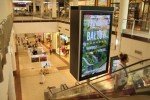invidis: Mr. Orzechowski, you have taken part in the first two DBCI surveys in Poland, how do you rate the results and their relevance for the Digital Signage industry?
Orzechowski: To begin with, I want to thank OVAB and invidis for the good cooperation. Introducing the DBCI in Poland was the first joint project of the Polish Digital Signage association – PDSA – and OVAB Europe since the signing of our cooperation agreement in September. From a business standpoint the DBCI provides us with a great tool to monitor the business situation and expectations in the market. To come back on the question, I see a clearly positive trend in the results of the January poll. Similarly the first poll in November seemed to reflect the overall Digital Signage market in 2013 very well. The DBCI shows almost parity with the three different answer categories, as our general perception is that the year 2013 was quite neutral for the industry in Poland. The market saw few but consistent new investments. The DooH market was very difficult due to low advertisement budgets. Many companies had sales difficulties but there were also some positive examples showing slightly increased revenues.

invidis: The analysis of the DBCI shows a positive trend, how do you rate the current business situation for Digital Signage in Poland?
Orzechowski: Yes, the increase of the DBCI by almost 16 base points is a clearly visible positive trend. I am particularly happy to see the high expectations for the next six months – almost 54% of all respondents expect a more favorable business situation. I personally agree with this view. However, I have a more conservative outlook. I assume that the first half of 2014 will be similar to 2013 but with a small uplift. We had a lively discussion during our last Digital Signage Trends conference in Warsaw, in November. Clearly the industry is still growing, new pilot installations are visible everywhere and some existing networks need their end-of-life revamps.
invidis: In the German speaking market the year 2013 started very positive, but lost some dynamic towards the end. How was the year 2013 for the Polish market?
Orzechowski: At the beginning of 2013 we wrapped up some big projects from 2012, but in general I think 2013 was more flat. The year saw some changes in the Digital Signage market in Poland. In the second half of 2013, new players took over some of the older projects, so we’ll have also new “blood” on the market – I hope they bring a lot of positive energy with them. A few projects from 2013 are still being rolled out, for example in the QSR segment.

invidis: And how do the other Eastern European countries compare?
Orzechowski: It depends and varies from country to country. When comparing the CSEE region: Poland, Czech Republic/Slovakia, Romania, Bulgaria, Hungary and the southern Balkan countries, for sure Poland is the most advanced Digital Signage market today. The Czech market is also very dynamic. A lot of projects were realized in retail, at gas stations, airports and universities. A very interesting project is the Digital Signage network currently in operation in the Prague metro. In Romania I was impressed by the big LED outdoor installations, but there are also a lot of good indoor projects, including retail, banking and telcos. In Croatia the year 2013 saw a start in DooH investments and quite a few small projects in the government sector, combining tourist information with local advertising campaigns. In general Digital Signage is growing everywhere in the CSEE and has a high potential.
invidis: Which main challenges will the Digital Signage industry in Eastern Europe and particularly in Poland be facing in 2014?
Orzechowski: For DooH a big challenge will be to introduce and brace common industry standards. In Poland we will try to adopt the OVAB standards, add local audits by research companies with the aim to install a clear and transparent DooH currency for ad impression measurement. This will help to convince the advertisers and media agencies that DooH is a media with high potential. For the general Digital Signage industry I see a high demand for continuous customer education, which will be step by step helping to create more value added projects. To set a standard and demonstrate the sustainability of Digital Signage installations, it is particularly important to realize projects with professional hardware – not only public displays and players, but also interactive systems and the creation of context aware content.
Download the complete DBCI January-February 2014 survey for Poland here.

